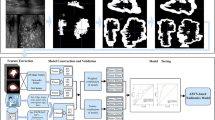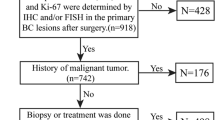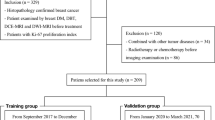Abstract
Objectives
To preoperatively evaluate the human epidermal growth factor 2 (HER2) status in breast cancer using mammographic radiomics features and clinical characteristics on a multi-vendor and multi-center basis.
Methods
This multi-center study included a cohort of 1512 Chinese female with invasive ductal carcinoma of no special type (IDC-NST) from two different hospitals and five devices (1332 from Institution A, used for training and testing the models, and 180 women from Institution B, as the external validation cohort). The Gradient Boosting Machine (GBM) was employed to establish radiomics and multiomics models. Model efficacy was evaluated by the area under the curve (AUC).
Results
The number of HER2-positive patients in the training, testing, and external validation cohort were 245(26.3%), 105 (26.3.8%), and 51(28.3%), respectively, with no statistical differences among the three cohorts (p = 0.842, chi-square test). The radiomics model, based solely on the radiomics features, achieved an AUC of 0.814 (95% CI, 0.784–0.844) in the training cohort, 0.776 (95% CI, 0.727–0.825) in the testing cohort, and 0.702 (95% CI, 0.614–0.790) in the external validation cohort. The multiomics model, incorporated radiomics features with clinical characteristics, consistently outperformed the radiomics model with AUC values of 0.838 (95% CI, 0.810–0.866) in the training cohort, 0.788 (95% CI, 0.741–0.835) in the testing cohort, and 0.722 (95% CI, 0.637–0.811) in the external validation cohort.
Conclusions
Our study demonstrates that a model based on radiomics features and clinical characteristics has the potential to accurately predict HER2 status of breast cancer patients across multiple devices and centers.
Clinical relevance statement
By predicting the HER2 status of breast cancer reliably, the presented model built upon radiomics features and clinical characteristics on a multi-vendor and multi-center basis can help in bolstering the model’s applicability and generalizability in real-world clinical scenarios.
Key Points
• The mammographic presentation of breast cancer is closely associated with the status of human epidermal growth factor receptor 2 (HER2).
• The radiomics model, based solely on radiomics features, exhibits sub-optimal performance in the external validation cohort.
• By combining radiomics features and clinical characteristics, the multiomics model can improve the prediction ability in external data.





Similar content being viewed by others
Abbreviations
- AUC:
-
Area under the curve
- CC:
-
Cranial caudal
- CI:
-
Confidence interval
- DM:
-
Digital mammography
- GBM:
-
Gradient boosting machine
- HER2:
-
Human epidermal growth factor 2
- IDC-NST:
-
Invasive ductal carcinoma of no special type
- LR:
-
Logistic regression
- MLO:
-
Mediolateral oblique
- ROI:
-
Region of interest
References
Hayes DF (2019) HER2 and breast cancer - a phenomenal success story. N Engl J Med 381(13):1284–1286
Bitencourt AGV, Gibbs P, Rossi Saccarelli C et al (2020) MRI-based machine learning radiomics can predict HER2 expression level and pathologic response after neoadjuvant therapy in HER2 overexpressing breast cancer. EBioMedicine 61:103042
Ocaña A, Amir E, Pandiella A (2020) HER2 heterogeneity and resistance to anti-HER2 antibody-drug conjugates. Breast Cancer Res 22(1):15
Loibl S, Gianni L (2017) HER2-positive breast cancer. Lancet 389(10087):2415–2429
Korde LA, Somerfield MR, Carey LA et al (2021) Neoadjuvant chemotherapy, endocrine therapy, and targeted therapy for breast cancer: ASCO Guideline. J Clin Oncol 39(13):1485–1505
Sauer G, Deissler H, Strunz K et al (2005) Ultrasound-guided large-core needle biopsies of breast lesions: analysis of 962 cases to determine the number of samples for reliable tumour classification. Br J Cancer 92(2):231–235
Mainiero MB, Moy L, Baron P et al (2017) ACR Appropriateness Criteria® Breast Cancer Screening. J Am Coll Radiol 14(11S):S383–S390
Conti A, Duggento A, Indovina I, Guerrisi M, Toschi N (2021) Radiomics in breast cancer classification and prediction. Semin Cancer Biol 72:238–250
Moy L, Heller SL, Bailey L et al (2017) ACR Appropriateness Criteria® Palpable Breast Masses. J Am Coll Radiol 14(5S):S203–S224
Independent UK Panel on Breast Cancer Screening (2012) The benefits and harms of breast cancer screening: an independent review. Lancet 380(9855):1778–1786
O’Grady S (1869) Morgan MP (2018) Microcalcifications in breast cancer: from pathophysiology to diagnosis and prognosis. Biochim Biophys Acta Rev Cancer 2:310–320
Elias SG, Adams A, Wisner DJ et al (2014) Imaging features of HER2 overexpression in breast cancer: a systematic review and meta-analysis. Cancer Epidemiol Biomarkers Prev 23(8):1464–1483
Hosny A, Parmar C, Quackenbush J, Schwartz LH, Aerts HJWL (2018) Artificial intelligence in radiology. Nat Rev Cancer 18(8):500–510
Choy G, Khalilzadeh O, Michalski M et al (2018) Current applications and future impact of machine learning in radiology. Radiology 288(2):318–328
Zhou J, Tan H, Bai Y et al (2019) Evaluating the HER-2 status of breast cancer using mammography radiomics features. Eur J Radiol 121:108718
Ma W, Zhao Y, Ji Y et al (2019) Breast cancer molecular subtype prediction by mammographic radiomic features. Acad Radio 26(2):196–201
Wolff AC, Hammond MEH, Hicks DG et al (2013) Recommendations for human epidermal growth factor receptor 2 testing in breast cancer: American Society of Clinical Oncology/College of American Pathologists clinical practice guideline update. J Clin Oncol 31(31):3997–4013
Patterson BK, Guevara-Coto J, Yogendra R et al (2021) Immune-based prediction of COVID-19 severity and chronicity decoded using machine learning. Front Immunol 12:700782
Chawla NV, Bowyer KW, Hall LO, Kegelmeyer WP (2002) SMOTE: Synthetic Minority Over-sampling Technique. J Artif Intell Res 16:321–357
Zhang HX, Sun ZQ, Cheng YG, Mao GQ (2019) A pilot study of radiomics technology based on X-ray mammography in patients with triple-negative breast cancer. J Xray Sci Technol 27(3):485–492
Wu M, Ma J (2017) Association Between imaging characteristics and different molecular subtypes of breast cancer. Acad Radiol 24(4):426–434
Wang L, Yang W, Xie X et al (2020) Application of digital mammography-based radiomics in the differentiation of benign and malignant round-like breast tumors and the prediction of molecular subtypes. Gland Surg 9(6):2005–2016
Jing R, Wang J, Li J et al (2021) A wavelet features derived radiomics nomogram for prediction of malignant and benign early-stage lung nodules. Sci Rep 11(1):22330
Oikonomou EK, Williams MC, Kotanidis CP et al (2019) A novel machine learning-derived radiotranscriptomic signature of perivascular fat improves cardiac risk prediction using coronary CT angiography. Eur Heart J 40(43):3529–3543
Zhou J, Lu J, Gao C et al (2020) Predicting the response to neoadjuvant chemotherapy for breast cancer: wavelet transforming radiomics in MRI. BMC Cancer 20(1):100
Yamada T, Mori N, Watanabe M et al (2010) Radiologic-pathologic correlation of ductal carcinoma in situ. Radiographics 30(5):1183–1198
Carey LA, Perou CM, Livasy CA et al (2006) Race, breast cancer subtypes, and survival in the Carolina Breast Cancer Study. JAMA 295(21):2492–2502
Isheden G, Grassmann F, Czene K, Humphreys K (2021) Lymph node metastases in breast cancer: investigating associations with tumor characteristics, molecular subtypes and polygenic risk score using a continuous growth model. Int J Cancer 149(6):1348–1357
Dawson SJ, Duffy SW, Blows FM et al (2009) Molecular characteristics of screen-detected vs symptomatic breast cancers and their impact on survival. Br J Cancer 101(8):1338–1344
Domingo L, Blanch J, Servitja S et al (2013) Aggressiveness features and outcomes of true interval cancers: comparison between screen-detected and symptom-detected cancers. Eur J Cancer Prev 22(1):21–28
Musolino A, Michiara M, Conti GM et al (2012) Human epidermal growth factor receptor 2 status and interval breast cancer in a population-based cancer registry study. J Clin Oncol 30(19):2362–2368
Grimm LJ, Johnson KS, Marcom PK, Baker JA, Soo MS (2015) Can breast cancer molecular subtype help to select patients for preoperative MR imaging? Radiology 274(2):352–358
Plichta JK, Thomas SM, Vernon R et al (2020) Breast cancer tumor histopathology, stage at presentation, and treatment in the extremes of age. Breast Cancer Res Trea 180(1):227–235
Keegan THM, DeRouen MC, Press DJ, Kurian AW, Clarke CA (2012) Occurrence of breast cancer subtypes in adolescent and young adult women. Breast Cancer Res 14(2):R55
Tahmassebi A, Wengert GJ, Helbich TH et al (2019) Impact of machine learning with multiparametric magnetic resonance imaging of the breast for early prediction of response to neoadjuvant chemotherapy and survival outcomes in breast cancer patients. Invest Radio 54(2):110–117
Zhao Y, Chen R, Zhang T et al (2021) MRI-based machine learning in differentiation between benign and malignant breast lesions. Front Oncol 11:552634
Ferre R, Elst J, Senthilnathan S et al (2023) Machine learning analysis of breast ultrasound to classify triple negative and HER2+ breast cancer subtypes. Breast Di 42(1):59–66
Li C, Song L, Yin J (2021) Intratumoral and peritumoral radiomics based on functional parametric maps from breast DCE-MRI for prediction of HER-2 and Ki-67 status. J Magn Reson Imaging 54(3):703–714
Zhou J, Tan H, Li W et al (2021) Radiomics signatures based on multiparametric MRI for the preoperative prediction of the HER2 status of patients with breast cancer. Acad Radiol 28(10):1352–1360
Geras KJ, Mann RM, Moy L (2019) Artificial intelligence for mammography and digital breast tomosynthesis: current concepts and future perspectives. Radiology 293(2):246–259
Gastounioti A, Oustimov A, Keller BM et al (2016) Breast parenchymal patterns in processed versus raw digital mammograms: a large population study toward assessing differences in quantitative measures across image representations. Med Phy 43(11):5862
Acknowledgements
We thank all authors who contributed to this study.
Funding
This project was supported by Clinical Research Plan of SHDC (grant no. SHDC2020CR4069), Medical Engineering Fund of Fudan University (grant no. yg2021-029), Shanghai Sailing Program (grant no. 21YF1404800), Youth Medical Talents–Medical Imaging Practitioner Program (grant no. 3030256001), and Shanghai Municipal Science and Technology Major Project (grant no. 2018shzdzx01).
Author information
Authors and Affiliations
Corresponding authors
Ethics declarations
Guarantor
The scientific guarantor of this publication is Dr. Li Liu.
Conflict of interest
The authors of this manuscript declare no relationships with any companies, whose products or services may be related to the subject matter of the article.
Statistics and biometry
No complex statistical methods were necessary for this paper.
Informed consent
Written informed consent was waived by the Institutional Review Board.
Ethical approval
Institutional Review Board approval was obtained from the Medical Ethics Committee of Fudan University Shanghai Cancer Center. The IRB number for this study is 1501143–8-NSFC. Written informed consent was waived.
Study subjects or cohorts overlap
No study subjects or cohorts have been previously reported.
Methodology
• retrospective
• cross sectional study
• multicenter study
Additional information
Publisher's note
Springer Nature remains neutral with regard to jurisdictional claims in published maps and institutional affiliations.
Supplementary Information
Below is the link to the electronic supplementary material.
Rights and permissions
Springer Nature or its licensor (e.g. a society or other partner) holds exclusive rights to this article under a publishing agreement with the author(s) or other rightsholder(s); author self-archiving of the accepted manuscript version of this article is solely governed by the terms of such publishing agreement and applicable law.
About this article
Cite this article
Deng, Y., Lu, Y., Li, X. et al. Prediction of human epidermal growth factor receptor 2 (HER2) status in breast cancer by mammographic radiomics features and clinical characteristics: a multicenter study. Eur Radiol (2024). https://doi.org/10.1007/s00330-024-10607-9
Received:
Revised:
Accepted:
Published:
DOI: https://doi.org/10.1007/s00330-024-10607-9




